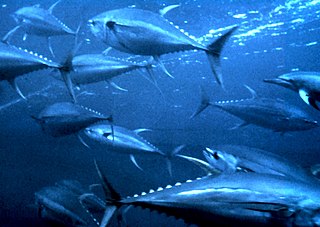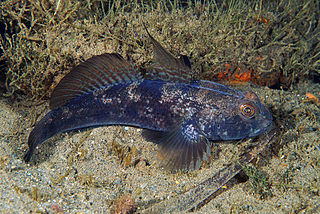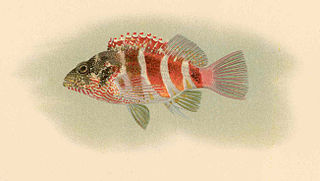
Fish locomotion is the various types of animal locomotion used by fish, principally by swimming. This is achieved in different groups of fish by a variety of mechanisms of propulsion, most often by wave-like lateral flexions of the fish's body and tail in the water, and in various specialised fish by motions of the fins. The major forms of locomotion in fish are:

Ridgeheads, also known as bigscales, are a family of small, deep-sea stephanoberyciform fish. The family contains approximately 37 species in five genera; their distribution is worldwide, but ridgeheads are absent from the Arctic Ocean and Mediterranean Sea. Although the family is one of the most widespread and plentiful of deep-sea families, none of its members are of interest to commercial fishery.

The Pacific staghorn sculpin is a species of marine ray-finned fish belonging to the family Cottidae, the typical sculpins. This species is found in the eastern Pacific Ocean. It is the only species in the monospecific genus Lepidocottus.

The black goby is a species of ray-finned fish found in the Eastern Atlantic and Mediterranean Sea and Black Sea. It inhabits estuaries, lagoons, and inshore water over seagrass and algae. It feeds on a variety of invertebrates and sometimes small fish. This species can also be found in the aquarium trade.

The black-axil chromis, also known as the blackfin chromis or blue-green puller, is a damselfish from the tropical Indo-Pacific. This fish can reach almost 12 centimetres (4.7 in) in length. It inhabits lagoons and reefs after settlement in the late-larval stage, and often occurs in large numbers, feeding above Acropora corals. This fish mostly feeds upon copepods, amphipods, and zoea.

The two-spotted goby is a species of goby native to marine and brackish waters of the eastern Atlantic Ocean where it can be found from the Faeroes and Norway to the northwestern coast of Spain. It has also been recorded from Estonia though records from the Mediterranean Sea are uncertain. They are common on all coasts of the United Kingdom. This species can reach a length of 6 centimetres (2.4 in) TL.

Eleutheronema tetradactylum, the fourfinger threadfin, is a species of marine ray-finned fish, a threadfin from the family Polynemidae which occurs in the Indian and western Pacific Ocean.

The common goby is a species of ray-finned fish native to fresh and brackish waters along the Atlantic and Baltic Sea coasts of Europe and northern Africa, with a range stretching from Norway to Morocco and Mauritania. It is also found in the Canary Islands. This species reaches a maximum length of 9 centimetres (3.5 in) TL.

The tub gurnard, also known as the sapphirine gurnard, tube-fish, tubfish or yellow gurnard, is a species of marine ray-finned fish belonging to the family Triglidae, the gurnards and sea robins. It is found in the eastern Atlantic Ocean. It is exploited by commercial fisheries as a food fish.

The Indian Ocean oriental sweetlips, also known as the oriental sweetlips or oriental blubberlips, is a species of marine ray-finned fish, a sweetlips belonging to the subfamily Plectorhinchinae, one of two subfamilies in the family Haemulidae, the grunts. It is native to the Indian Ocean and the western Pacific Ocean.

The blue trevally, also known as the banded trevally, barred trevally, Ferdau's trevally or Forskaal's jackfish, is a common, widespread species of pelagic marine fish classified in the jack family, Carangidae. The blue trevally is distributed throughout the tropical and subtropical waters of the Indo-Pacific and central Pacific regions, ranging from South Africa in the west to Hawaii in the east. It is a moderately large fish, growing to a recorded maximum length of 70 cm, with the number of rays in the second dorsal fin and the colouring serving as diagnostic features of the species. The species inhabits waters to depths of 60 m, generally inhabiting reefs, beaches, lagoons, and areas with sandy substrates. It is a predatory fish, taking other fish, prawns, crabs, and molluscs, and very little is known of the species' reproductive biology. The blue trevally is of varying importance to fisheries throughout its range, with some regions having high catches of the fish. It is considered to be a gamefish, and is sought after for its excellent eating qualities.

The popeye catalufa, also known as the bigeye soldierfish, is a species of marine ray-finned fish in the family Priacanthidae, the bigeyes. This fish has an overall dusky orange to red colour with white markings. The dorsal fin appears feathery while rest of fins have black margins. It occurs in the eastern Pacific, where it is found from Oregon to Chile. It occasionally makes its way into the aquarium trade. It grows to a size of 34 centimetres (13 in) in length. This species is nocturnal and shy, preferring deeper waters off islands. It has been recorded associating with squirrelfishes and cardinalfishes but the popeye catalufa goes as deep as 76 metres (249 ft), deeper than its associated species. This species has been recorded from rocky habitats at depths of less than 5 metres (16 ft) to over 100 metres (330 ft). It is a carnivorous species and, when kept in captivity, is known to feed on worms, crustaceans and brittle stars.

Menticirrhus saxatilis, the northern kingfish or northern kingcroaker, is a species of marine fish in the family Sciaenidae. It lives in the shallow coastal waters of the western Atlantic Ocean and Gulf of Mexico.

Valenciennea helsdingenii is a species of goby from the Indo-Pacific. It is commonly known as the twostripe goby, black-lined sleeper goby, or railway sleeper goby. It can grow up to a length of 25 cm (9.8 in) and is distinguishable by two prominent orange to black lines running longitudinally through its body.

Trimma nasa, commonly called the nasal dwarfgoby or nasal pygmy goby, is a species of goby from the Western Pacific. They are small fish, averaging at around 2 cm (0.79 in) in length. They are bright orange and transparent yellow in life, with a white stripe running down from between the eyes to the upper lip and a dark brown spot at the base of the tail fin. They are usually found in large schools in the sloping or vertical drop-offs at coral reef edges.

Pomadasys maculatus, commonly known as the saddle grunt, blotched grunt or blotched javelin, is a species of marine ray-finned fish, a grunt belonging to the family Haemulidae. It is native to the Indo-West Pacific region.

Cottunculus microps, the polar sculpin, is a species of fathead sculpin, a deepwater fish found in the North Atlantic and Arctic Oceans. It was first described in 1875 by the Norwegian zoologist Robert Collett, curator of the Natural History Museum at the University of Oslo.
Elacatinus colini, the Belize sponge goby, is a species of goby native to the Western Central Atlantic Ocean, near Belize and Honduras.

The redbarred hawkfish is a species of marine ray-finned fish, a hawkfish belonging to the family Cirrhitidae. It is endemic to the Hawaiian Archipelago in the Pacific Ocean.

Lophogobius cyprinoides, commonly known as the crested goby, is a small fish that is widespread throughout the western Atlantic Ocean.




















